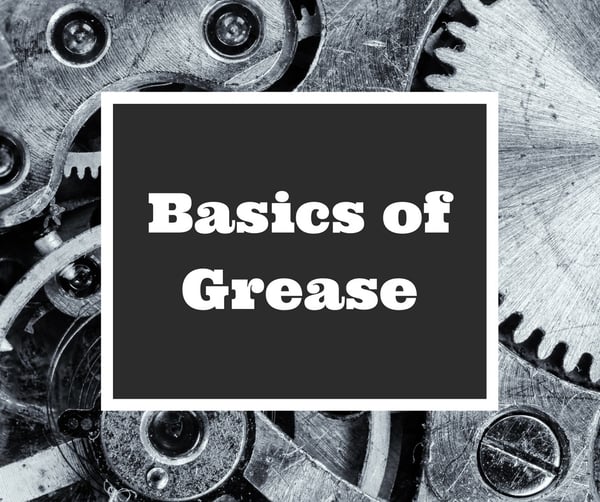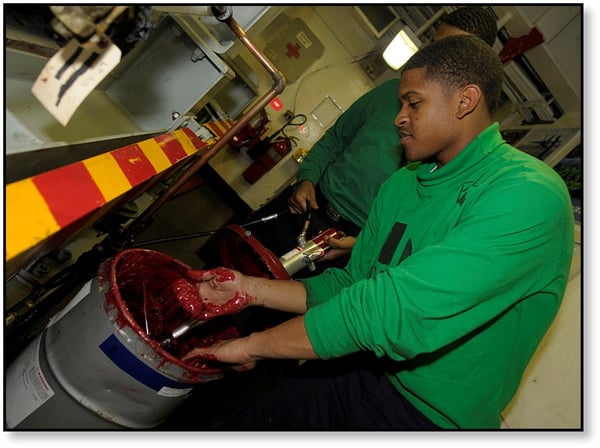In this Shop Talk Blog, our focus is going to be on the basics of grease as a lubricant. We’ll try to answer some of the most common questions about grease, such as what it is, what it does, and where it is used. We’ll also talk about shear thinning and whether you can substitute grease for oil.

Here are some additional blog posts you might be interested in ...
- Lubricants: An Investment in Your Heavy Equipment
- 3 Things You Should Know About Gear Oil for Final Drives
- How to Check and Change the Gear Oil in Your Final Drive
What Is Grease?
Grease is a semisolid lubricant that is comprised of oil (amount to about 85% by volume and typically using a vegetable or mineral oil) suspended in a thickener. The thickener acts somewhat like a sponge as it holds the oil in place and releases it was needed. Grease is much thicker than oil and can seem almost solid at extremely low temperatures. Unlike oil, it retains its shape and doesn’t assume the shape of the container). Grease usually has additives included to provide additional properties (e.b., EP grease has graphite or molybdenum disulfide added for improved performance in extreme pressure environments).
 By U.S. Navy photo by Mass Communication Specialist Seaman Zachary David Bell [Public domain], via Wikimedia Commons
By U.S. Navy photo by Mass Communication Specialist Seaman Zachary David Bell [Public domain], via Wikimedia Commons
What Does Grease Do?
Grease provides …
- Lubrication
- Provides a barrier between sliding and rolling metal-to-metal contact
- Reduces friction
- Protect components from corrosion and contaminants
However, grease cannot reduce friction as much as oil. It also cannot remove heat from crucial components like oil can.
What are the Key Characteristics of Grease?
When selecting a grease for an application, engineers usually focus on these three properties:
- Viscosity of the base oil
- Operating temperature range
- Load carrying capabilities
- Corrosion-resistance
Where is Grease Used?
Here are some examples where grease would be used instead of oil:
- Equipment that must set for extended periods of time, or only runs intermittently, because it is vital that lubrication is in position as soon as the equipment is started
- Components that are difficult to reach for frequent lubrication or are sealed (e.g., sealed bearings)
- Situations where oil would not be able to remain in position
- Environments where materials would experience a corrosive reaction when exposed directly to oil (e.g., rubber)
- Extreme operating conditions such as shock loads (where oil films would rupture and fail to provide protection) or extremely high temperatures (where oil viscosity would become too thin)
 By Surv1v4l1st [CC BY-SA 4.0 (https://creativecommons.org/licenses/by-sa/4.0)], from Wikimedia Commons
By Surv1v4l1st [CC BY-SA 4.0 (https://creativecommons.org/licenses/by-sa/4.0)], from Wikimedia Commons
Are Grease and Oil Interchangeable?
Grease and are not interchangeable. They may share some characteristics, but their purposes and suggested operating conditions are quite different. If your equipment calls for oil, don’t use grease instead.
What is Shear Thinning?
True grease exhibits an interesting property called shear thinning or thixotropy. As a force or load is applied to grease, it exhibits a high level of viscosity. But as the shear force applied is increased, the viscosity of the grease begins to drop until it reaches that of the base lubricant contained in the grease mixture. Paint, ketchup, and nail polish are also examples of shear thinning materials.
It There Any Such Things As Too Much Grease?
Indeed there is! Consider an anti-friction ball bearing. With too much grease, the balls have to expend more energy trying to plow through the excess grease. Too much grease also leads to a build-up in heat (which can be difficult to conduct away from critical components). If the heat reaches a high enough point, then the oil film can begin to dissipate, and further damage is done. Bearings or races that have a blue-black hue to them are showing evidence of overheating.
Conclusion
Grease is a lubricant but serves a very different purpose from oil because of its semisolid nature and shear thinning behavior. It works well in situations that oil doesn’t, and isn’t interchangeable with oil.
Texas Final Drive is your partner in providing new or remanufactured final drive hydraulic motors from a single mini-excavator to a fleet of heavy equipment. Call today so we can find the right final drive or hydraulic component for you, or check out our online store to find your O.E.M. manufacturer brand motor now.

